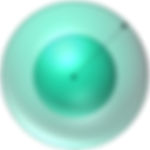Sound attenuation through the air.
- Michael Maggs
- May 19, 2022
- 2 min read
Updated: Jan 9
When an animal calls, the sound is attenuated as it travels over a distance to the recorder.
Spreading loss and Absorption loss are the two main sources of attenuation.
Spreading loss
As sound waves expand out volumetrically from their source, the air pressure, or intensity, of those waves also drops, like the walls of a balloon getting thinner as it expands. In other words, the same sound power that was at the point is now spread over the surface of an ever increasing sphere as the sound propagates outwards.

We can work out the spreading loss of a sphere from the formula for its surface area:
A = 4πr^2
So as r increases the sound pressure decreases by 1 ∕ r^2.
Converted into decibels, the spreading loss of a sphere in dB is
As = 20log10(r)
Below is a table of distances r from a sound source and the relative intensity and spreading loss in dB that sounds would experience over that distance.
Range r (m) | Relative Intensity | Spreading Loss (dB) |
1 | 1 | 0 |
10 | 1 / 100 | 20 |
100 | 1 / 10,000 | 40 |
1000 | 1 / 1,000,000 | 60 |
So if the loudness of your sound source was 70dB SPL at 1m then by 100m away it would suffer 40dB of attenuation, i.e. it would only be 30dB SPL when it reached you. At 1000m it would be 10dB SPL, which is below the detectable threshold of our microphone (14dB SPL).
Absorption Loss
As sound waves propagate through the air, some of their energy is absorbed by the air itself as heat, as the coherent molecular motion of the sound waves are converted into incoherent molecular motion.
This attenuation varies greatly with temperature, water-vapor content, and frequency, but in most cases can be ignored when considering sounds in the audible range <20kH. However, this can have a significant impact in the ultrasound band for bats.
Below is a table of absorption loss in dB / km, at T=20^𝑜C and P=101.325kPa.
Absorption Loss ( dB / km )
Frequency (kHz) | Relative humidity (%) | | | | | ||||
|---|---|---|---|---|---|---|---|---|---|
10 | 20 | 30 | 40 | 50 | 60 | 70 | 80 | 90 | |
1 | 14 | 6.5 | 5 | 4.7 | 4.7 | 4.8 | 5 | 5.1 | 5.3 |
2 | 45 | 22 | 14 | 11 | 9.9 | 9.3 | 9 | 9 | 9.1 |
5 | 130 | 110 | 74 | 55 | 44 | 38 | 33 | 31 | 8 |
8 | 180 | 220 | 170 | 130 | 110 | 89 | 78 | 69 | 63 |
10 | 190 | 280 | 240 | 190 | 160 | 130 | 120 | 100 | 95 |
20 | 260 | 510 | 600 | 580 | 520 | 470 | 420 | 380 | 350 |
50 | 600 | 940 | 1300 | 1500 | 1700 | 1700 | 1700 | 1700 | 1700 |
100 | 1800 | 2200 | 2500 | 2900 | 3600 | 3600 | 3800 | 4000 | 4100 |
* table data from http://www.kayelaby.npl.co.uk/general_physics/2_4/2_4_1.html
This absorption loss can be simply subtracted from our original signal power level, like we did for the spreading loss.
So, like our previous example if we have a 70dB SPL call that has most of its energy at 10 kHz and it’s 20°C with 30% humidity, then by 100m away we can expect it to suffer 40+7.4dB of attenuation (spreading loss + absorption loss), i.e. it would only be 22.5dB SPL when it reached you.

